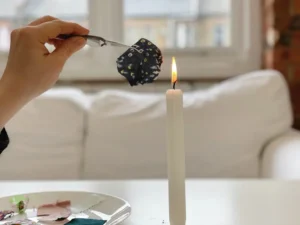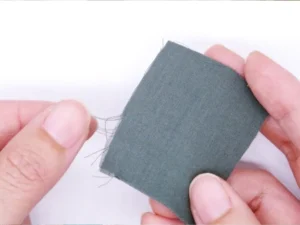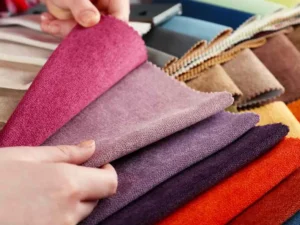Different fabrics are used in making clothes and apparel, and each has different properties. Knowing the content of the fabrics is crucial. Unfortunately, 99% of people don’t know how to check fabric compositions. The content of the fabric can be easily identified through a burn test. This includes burning of a small part or sample of cloth. Each different fiber gives a different flame color, odor, and burnt. By analyzing these elements, one can quickly identify the fabric composition.
You’ll need to know the fabric’s composition and identification at times. However, the processes for their identification and composition are different. In this guide, we will explore everything about the identification and composition of fabrics. So, let’s get started!
Identification of the Fabric Via Burn Test

Each cloth can consist of different fibers or only a single one. Identifying the fabric composition is very helpful. Usually, a burn test is used in fabric identification. The reason is that it is inexpensive and practical. It is also considered reliable as compared to all other identification tests. In the section below, I’ll discuss the method of burn test used for fabric identification.
Required Material
To conduct a burn test, you’ll need some equipment. Without these, you’ll put your safety at risk. Here is the list of those tools:
- scissors
- Lighter or Candle
- Ashtray or any aluminum pot
- Tweezer for handling
Having tweezers, candles, and an ashtray is mandatory. They help you stay away from the flame, so even if the fabric melts and goes down, it won’t harm you.
The Procedure of Burn Test
First of all, cut the piece of fabric with the help of a scissor. There is no strict rule about how long the piece should be. However, make sure that it is big enough so that you can hold it with tweezers. Once the fabric piece is ready, put the candle on the flame.
You can also use different sources for flames, such as lighters, matchsticks, etc. However, I highly recommend using candles. You won’t have to hold the candle in your hands; it will save you from fabric residue if it melts.
Bring the piece of fabric close to the flame. Burn one corner of the cloth. Once it catches the fire, bring it away from the flame. This is a crucial phase, as you’ll have to observe the flame color, odor, and ease of burning. Each fabric has different properties when it burns; you’ll have to analyze them carefully.
Here are a few things that you keep in mind while analyzing:
- How easily does a fabric get ignited?
- Does fabric undergo charring or melting?
- How does fabric smell during its ignition?
- After removing the swatch, does the fabric continue burning?
- How does the fabric look when the whole piece is burnt?
These points will help you identify the fabric. As I said earlier, each fiber exhibits distinct behavior when it burns. Keep analyzing the properties during the burning process. At the end of the process, you can identify the fabric content. This method of burn testing is considered very reliable.
Quick Tip: If the piece burns quickly and produces a yellow flame, it is cotton. It will smell like burning paper. Similarly, if the fabric smells like burning wood, it would be Rayon. Silk pieces will burn slowly and produce a hair-burning smell.
How to Check the Fabric Composition of Knitted Fabrics?

In the above section, I’ve explained the method of fabric identification. However, the percentage composition of any fiber in knitted fabric is different. It requires both analysis and mathematical calculations. The section below discusses the method of finding the percentage composition of fabrics.
- First, take a small piece of fabric. It can be any size, but a smaller piece is recommended.
- Weight this piece of fabric on the digital measurement device or unit. Make sure that the unit does not have any other contaminants. Otherwise, it will add a small weight to the piece, making the reading incorrect.
- Take a yarn (of any one color, let’s say green yarn) from the corner of the piece of fabric. Remove that complete yarn from that piece. This step requires some time and patience. You’ll have to remove the yard carefully to not affect the whole fabric.
- Once the green yarn is taken, now weigh this yarn on the digital measurement device. Note the weight on any paper.
- After weighing yarn and fabric, it is time to do mathematical calculations. Those calculations are as follows:
The percentage composition of fabrics
Formula to find percentage composition = piece of single yarn / Total weight of cut piece × 100
You can put the value in the above formula. As per my previous instructions, you’ll have the weight of the fabric piece as well as the weight of the yarn.
Let’s assume for now that the total weight of a piece is 0.50 g and a single yarn has 0.10g of weight. Yarn So, according to these values:
Percentage composition = 0.10 / 0.50 × 100 = 20%
This indicates that green yarn will make 20% of knitted fabric. Keep in mind that this is a sample test. However, it is not 100% accurate. People use it to estimate the composition of fibers in knitted or general fabrics.
Quick Tip: You can use any color yarn from a sample piece to meet your needs and preferences. The method stated above applies to every kind of yarn. However, make sure that the weight readings are accurate. The measurement device should not contain any impurities or contaminants.
Different Types of Fibers
Each fabric consists of different fibers knitted together. Each of those acts differently when they are heated. In burn tests, those fibers are easily identifiable. The main types of fibers are as follows:
- Plant fibers (Cotton, Linen)
- Animal fibers (Wool, Silk)
- Synthetic Fibers (Polyester, Nylon, Acrylic)
These fibers provide different smells and properties when undergoing a burn test. The section below will explore their behavior and properties during the testing. You’ll recognize the fabric content by analyzing these smells, odors, etc.
1- Plant-Based Fibers (Cotton and Linen)
Cotton, linen, bamboo, and Rayon are plant-based fibers. They are used in making fabrics. Although they all belong to plant-based fibers, they behave differently when heated. Here is the overview of their behavior:
- Cotton: It burns quickly in no time. However, it smells like burning papers. It will produce a brighter flame, and flaky ash will result.
- Linen: Surprisingly, the linen behaves more like cotton. It quickly burns and produces paper that smells just like cotton. After the burning process, you’ll get pale color and flaky ash.
- Bamboo: It is different from cotton and linen. It does smell like burning paper. Instead, it is more toward wood and smells like burning wood.
- Rayon: Among all the fibers, it burns slowly. However, it also produces an awkward smell that is more like punging chemicals. As far as the residue is concerned, it also makes the charred residue.
2- Animal fibers (Wool, Silk)
Almost all animal-based fibers exhibit similar characteristics. They don’t burn quickly but don’t melt as well once brought near the flame. As far as their smell, they give off a pungent odor, more like hair burn.
Wool, silk, and all other animal fibers are soft. On burning, they produce ash that can be readily crushed. None of them give afterglow, a characteristic of cotton or animal-based fibers. Silk is slightly different from wool.
The reason is that it produces a hissing sound during burning.
If the animal fibers do not produce sound, it would be wool. It causes a hissing noise; it would be silk. Their identification is relatively easy. Animal fibers differ slightly from each other in their properties depending on the environment. In a controlled environment, they exhibit the properties mentioned above.
3- Synthetic Fibers (Polyester, Acrylic)
Acrylic, polyester, nylon, etc, are synthetic fibers. They are all used in cloth and fabrics. However, they differ from plant and animal fiber by a significant margin. The synthetic fibers melt when they come near the flame during the burn test.
Their smell is not pungent. If you burn synthetic fiber in a room and you sit in that room, you won’t feel bad. It produces a sweet smell. As I said, the artificial fiber does not burn. Instead, it melts, making a melted residue like a plastic bead.
Important Point: It is vital to remember that all these fibers used in fabrics are checked under the burn test I mentioned at the start. You will need the same setup of a burn test for all the fibers. After analyzing, you’ll identify the specific fiber used in the fabric.
Other Ways to Check Fabric Composition

The burn test method is reliable and easy to conduct. However, many other common ways to identify fabric content are also available. But I don’t recommend you rely on those methods. The reason is that they are not always accurate and reliable. Those tests include:
- Feel Test
- Bleach test
- Water/Acetone Test
These tests do not involve any rocket science. Anyone with fabric experience can perform them and identify fabric composition. The section below will give you an overview of these tests.
1- Feel Test
As I said earlier, this method of fabric identification is considered unreliable. Usually, the garment shop owner uses this technique to check the composition of the fabric. Unfortunately, some ill-minded shop owners also use this technique to scam customers.
However, an experienced person can use this Test to identify the fabric’s composition. Each fiber gives a different feel when you touch it. For example, cotton feels soft on the touch. Similarly, wool and silk feel warm and silky, respectively. It is all about practicing and understanding each fabric’s feel.
The feel test does not involve a specific process. The customer puts their fingers on the cloth to feel the fiber. If you are a customer and will buy fabric, don’t just rely on the feel test. Make sure to read the label that the manufacturer puts on the cloth. These labels tell you about the content of the fabric.
2- Bleach Test
The bleach test is more reliable than the feel test. This method consists of a weak bleach solution. However, it can be risky for some fabrics. You’ll need a small piece of the fabric you want to identify. Put this fabric in a smaller container.
Put a weak bleach solution into this container. Leave the container for 25 to 30 minutes. Once time is reached, check the color of the piece of cloth. Different fibers react differently when put into the weak bleach solution. Here is how different fibers act during the bleach test:
| Fiber | Bleach Reaction |
| Cotton | Turns slightly yellow |
| Flax (Linen) | Turns brown |
| Rayon | Turns off-white |
| Polyester | Usually retains color |
| Nylon | Usually retains color |
3- Water/Acetone Test
This identification method is not standard, but some people still use it. You’ll have to put a few drops of water or acetone on the fabric under the Test. You’ll identify it based on its reaction with the water. Keep in mind to use a small piece of fabric for testing.
Put a few drops of water on the piece of fabric. After a few 30 seconds, analyze the fabric. Check if the water is absorbed by the fabric piece or not. Natural fiber, such as cotton linen, etc, absorbs the water. You’ll feel that the fabric will become damp.
The synthetic fiber won’t absorb the water. Instead, the drops will remain on the surface of the fabric. Even if you move such a cloth, the water drops will also move on the fabric’s surface. This is how you can analyze and identify the content of the fabric.
Point to Remember: All the above tests and methods are just for identifying fabric content. None of them gives information about the quality of the fabric. Other methods and machines, such as abrasion and pilling testers, are used to test the quality.
Conclusion
Knowing the fabric composition is crucial for both industries and customers. You can find out the content of the fabric by reading the labels. However, testing the fabric is also helpful to obtain more comprehensive details.
In this guide, I have explained all the tests and methods that can be handy in the identification process. You can explore this platform and get more details about the environmental chambers. This comprehensive guide will prove to be helpful.